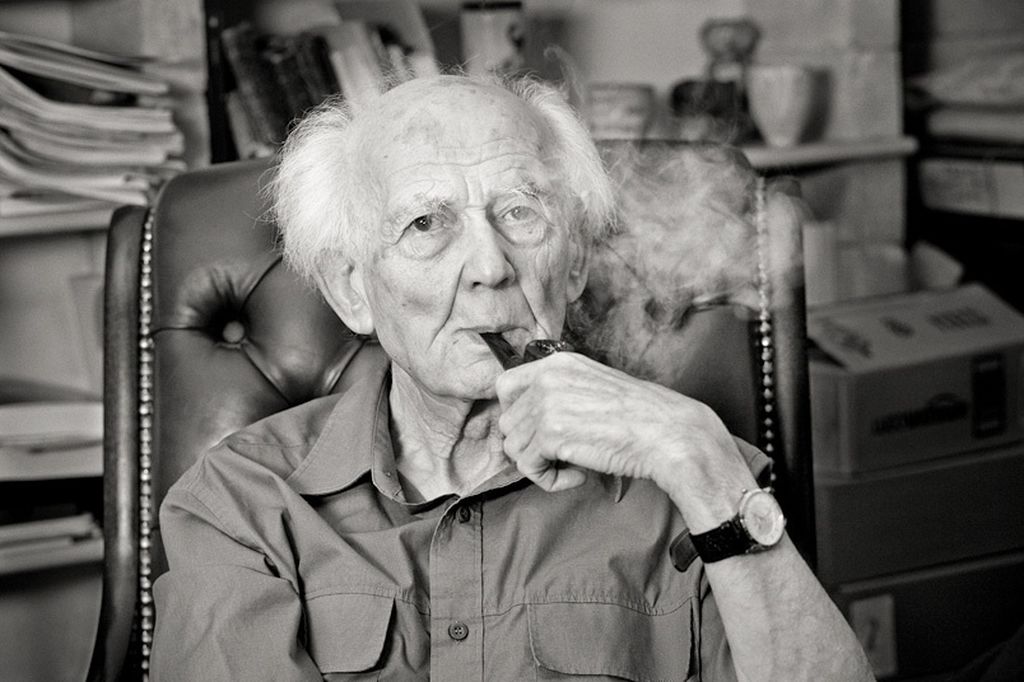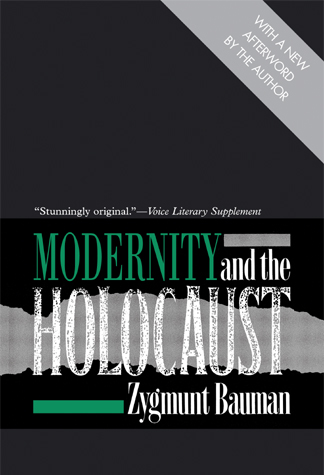Natan Sznaider, Academic College of Tel-Aviv-Yaffo
Many of us were deeply impressed when Zygmunt Bauman published his “Modernity and the Holocaust” almost a quarter century ago. When I studied sociology in the 1970s there was not much sociological thinking going around about the Holocaust.

When the book came out we weren’t very aware of the consequences. The book came out when the Berlin Wall fell and one year later, Germany was reunified and I would argue that these things are connected. Bauman himself was much more aware of the context. In his Amalfi Prize lecture Bauman was very clear about the context of his book and I quote him: “The ideas that went into the book knew of no divide; they knew only of our common European experience, of our shared history whose unity may be belied, even temporarily suppressed, but not broken. It is our joint, all European, fate that my book is addressing“ (p.208 of the second edition of Modernity and the Holocaust).
Now, almost 30 years after the fall of the Berlin Wall, “The German problem is no more,” seems to be the current dominant sound. Many Europeans still feel a bit uncomfortable with that statement, but it takes hold. Germany has turned into the almost unchallenged leader of the European Union. Now, this process is also accompanied by social theory, and I think that we may have to draw some connections between memory and the social theory of the Holocaust. I think this might be the wider context of Bauman’s book.
When I was younger, the Holocaust and the rise of the Nazis were explained in terms of Germany’s exceptional national development – the so-called Sonderweg thesis. There was not much need for sociology of the Holocaust.
I remember reading an essay by Parsons from 1942 “Democracy and Social Structure in Pre-Nazi Germany.” (This essay, like others, were part of Parson’s radio addresses during the war. They have been collected in a reader edited by Ute Gerhardt called Talcott Parsons on National Socialism.) I think they are still worthy of our attention. In it, Parsons draws a line between Anglo-Saxon democracies and Germany where feudal, militaristic, bureaucratic and authoritarian are interdependent. Norbert Elias was also influenced by Parsons (Bauman criticizes Elias for that in the book, but I think he bends him a bit). Goldhagen would add some sensational account to this in 1996, Hitler’s Willing Executioners, but that book mostly made sense to those who believed that it were the Germans who killed the Jews. Clearly, there was an argument made that “blamed” Germany and Germans for what has happened.
Now, this seems to be turned on its head. Globalized memory of the Holocaust takes it out of the framework of the German nation and resets it into the context of modernity.

In Bauman’s theory, and I would argue also in the new politics of memory in Europe, Germany ceases to be the exception to the standard path of European national development and becomes instead the exemplification of a common modernity. WWII was not a disaster suffered by Germany alone. It was a disaster suffered by all of Europe, and one which was created by all of Europe in the war before. Germany was simply its epicenter, as it was the epicenter of accelerating industrial development and efficiency and the stress they placed on society. The memorial in Berlin is a good case in point, which argues in its aesthetic way for the generalization of the Holocaust.
As for the “After period,” it was also not simply the aftermath for Germany, but a new phase for all of Europe. It was the beginning of the European Union, which marked a new beginning of a new phase in modernity, a cosmopolitan rather than nation-state modernity. Germany apparently was ahead of the others in its incorporation into transnational organizations. It was the most committed to building an international law to replace the law of the jungle that had previously regulated the interaction between states. It was the most eager nation to submit to this new and transformative second-order social contract. And not only was it eager to submit to this order, but it took on a leading role in it and tried to submit other Europeans to this view. Just look at Germany’s response to the refugee crisis. It is the special path theory of Germany put into action to do “good” and Germany’s surprise when other nations do not follow suit.
So what is wrong with this picture?
Well, to start with, fascism and the Holocaust can only exemplify modernity if Germany exemplifies modernity. But is that true? The conventional picture has been that Germany and Italy and Japan were all exceptions to the normal path of modern development, and all deviated in similar ways. They all developed late, both as nations and as national economies. The conventional wisdom has been that this accelerated development caused more stresses than if it had happened more slowly; national pride was aggrieved by what was perceived as a disadvantaged position about to be set in stone; and democratic institutions and political culture never had time to set in the national character before they were washed away in a flood of nationalism.
That is of course a huge simplification of a huge debate. However, the fact remains that Germany is not generally considered the rule of modernity, but rather its exception. So how can this be inverted and make Germany modernity’s focal point? If we identify the most nationalist states as the most modern, then not only do the exceptions become the rule, but the rules become the exception. Under this view, the two countries generally considered to exemplify modernity become transformed into weird outliers. Because it is an immigrant nation, the USA has had one of the least ethnic conceptions of its national identity. And Britain, on the eve of WWII was, the world’s largest empire; a state of multiple nationalities even on its home islands. So looked at closely, neither can be said to exemplify the ethnically homogenous nation state. Does that mean they are the ones that exemplified modernity the least? Thus, to speak in the language of Bauman, in their garden there are lots of parts which do not seem to fit. Something seems clearly wrong here. I’m not saying you can’t understand the world in these terms; many have done this. But you can’t call what you are describing modernity. This is not deepening a framework, this is turning it inside out and calling black white. Bauman challenges these views, but I didn’t find really anything in the book that actually challenges seriously the Sonderweg thesis. In my opinion, his views are informed by mis-readings of Elias (especially his study on “The Civilizational Process”). He bends Elias a bit to fit the theory. There’s nothing wrong with that – we all do this once in a while. He produces his own convenient Elias as a theorist of uni-linear evolutionism towards a violent-free world. However, there is more at stake here. I think that Bauman’s views of sociology and theories of socialization are rather weak as well. Even when he talks about moral judgment he almost purposely misreads Arendt’s views on judgment as being a-social. One should be a bit more careful when Bauman tries to be in the company of Arendt. We should not forget that she emphasized the point of unprecedentedness when she talked about the Holocaust and that her views were much too existential to give modernity such a deterministic role. There is a lot of theoretical thinking going around showing how morality is deeply connected to socialization. Bauman just dismisses those out of hand.
Bauman, in his 2000 postscript, relates himself to Agamben and this is, of course, no coincidence. There is a problem of distinctions here. To them, the totalitarian state and the liberal state of law are too similar to justify making a distinction. Thus, in my opinion very important distinction drawn by Arendt and also by Jaspers between criminal states and states which commit crimes gets lost in theory. The result is a banalization: Auschwitz is everywhere. The camp undifferentiated like everything else in his theory becomes the central metaphor for modernity altogether. The West Bank Separation Fence is then quickly transformed to the walls of the Warsaw ghetto as Bauman recently argued in a Polish magazine. In this respect, you are in the same league as those who argue that the Iranians are Nazis, that the Palestinians are Nazis, that it is Munich all over again and your answer is, and that Israelis are actually Nazis and that “Nazi” becomes a catch all metaphor for being a bad person. In many ways, these are games which children like to play accusing each other to have destroyed each other’s’ toys. I am not saying that Bauman does that, but he also doesn’t not do it. When you think that the technologies of genocide and those of occupation and other historical injustices can be productively compared, you leave social theory and become a polemicist. As such, Bauman is playing this to high art. However, even it may make sense in the game of scoring some political points, in terms of both social theory and history it makes no sense at all. There is no new enlightenment behind that, only contempt for modernity. Anti-modernism is no critique of modernity.
Note: You can find the second part of Natan Sznaider’s critique here.
Natan Sznaider is professor of sociology at the Academic College of Tel-Aviv-Yaffo in Israel. His books include Jewish Memory and the Cosmopolitan Order (2011), Human Rights and Memory (with Daniel Levy) (2010), The Holocaust and Memory in the Global Age (with Daniel Levy) (2005). His forthcoming book is titled Memory and Forgetting in the Post-Holocaust Era. The Ethics of Never Again (co-authored with Alejandro Baer) (Routledge, 2017).

Comments 1
Multiple Modernities and the Nazi Genocide: A Critique of Zygmunt Bauman’s Modernity and the Holocaust, pt. II – The Center for Holocaust & Genocide Studies — August 17, 2016
[…] This is the second half of Natan’s critique of Bauman’s Modernity and the Holocaust. You can find the first half here. […]